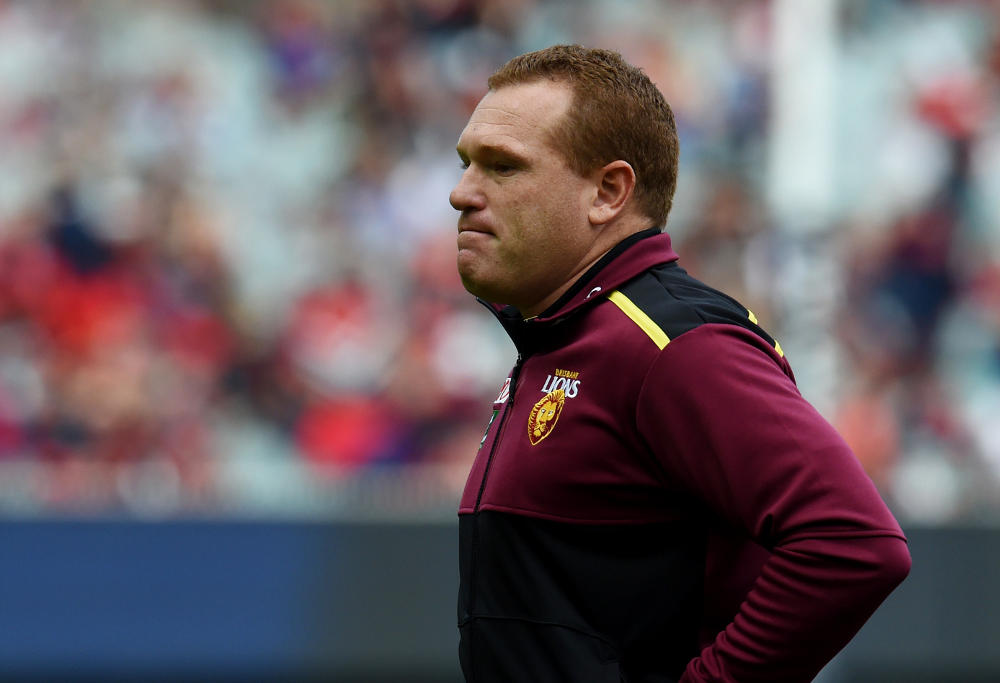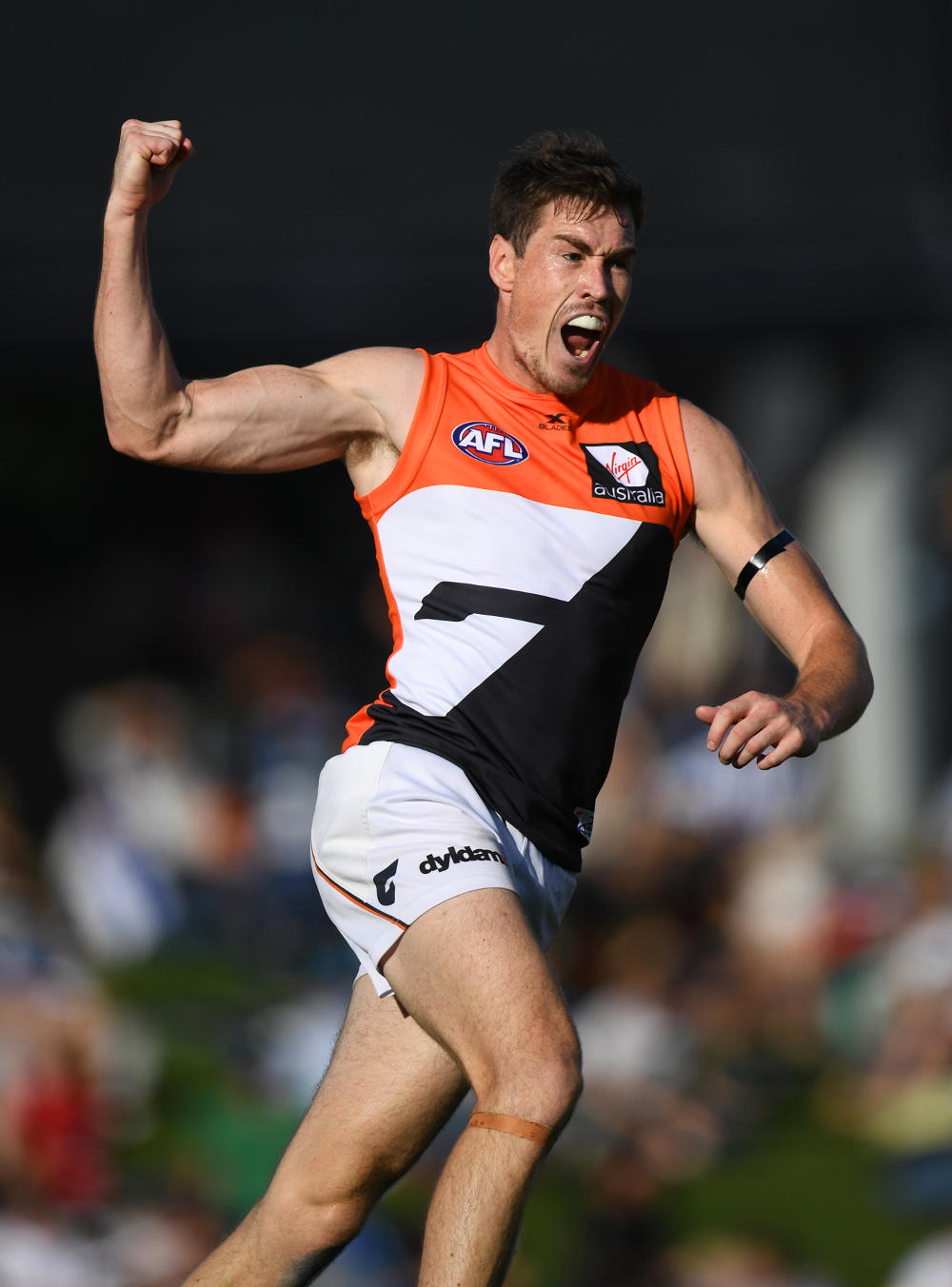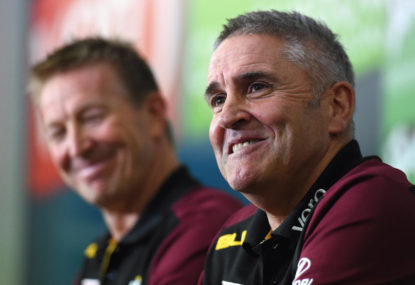So long neglected, the Lions of Brisbane are threatening to become interesting again. With a bevvy of key-position talent and a revamped administration, optimism abounds in a way it has been unable to since the very early days of Michael Voss’ reign at coach.
Right now, Brisbane are still the worst team in the competition. Over 18 rounds, they have won four games, with a league-low percentage of 71.8 per cent.
On more sophisticated metrics, the Lions have only delivered the goods well enough to earn three wins (Pythagorean wins), albeit they have once again managed to be stuck with one of the most difficult draws in the competition (despite finishing 17th last season).
No team sets out to win four in 17 games. For Brisbane though, this is not an unwelcome development. After last season’s three win, 61.6 per cent debacle, a new coach means this year was a development-focussed free hit.
Chris Fagan has made his mark, albeit you’ve got to squint a little to see it. Squint we will.
For the Lions though, the real season begins in about two months’ time. Their list, the youngest in the competition and chock full of promising key position talent, could be blown to bits. For most rebuilders that would be a disaster – doubly so given the recent history of the Lions and their struggles with retention of draftees. But Brisbane finds itself in a unique position, flush with assets that are in demand across the league which are incongruent with the team’s broad direction.
Uncertainty reigns; that’s the price of building the bookends first. But the potential for upside is undeniable. There’s a chance 2017 is the off season that will lay the foundations for Brisbane’s next tilt at a premiership.
Put the fire out
The five years leading up to the removal of Justin Leppitsch as coach were not much fun for the Brisbane Lions or its fans.
Two and a half years of false dawns and disappointment under Michael Voss gave way to two and a half years of awful malaise under Leppitsch. The Lions became a defensive laughing stock, giving up a historic, and comical, 131 points per game in 2016 – one of the worst rates ever, and close to eight goals more than the league average that season.
Off the field, Brisbane committed hard to two things: youth, and Queensland talent. That policy was born of Brisbane’s challenges with draftee retention in the earlier part of this decade. The disastrous 2013 off season saw the Lions lose Elliot Yeo, Sam Docherty and Jared Polec, three high-picks from 2010 and 2011.
In the years following, the Lions also traded draftees James Aish, Jack Crisp and Jack Redden, and last year Pearce Hanley moved south for the winter.
The Lions have been tarred with the ‘retention issues’ brush. It is a situation doubtlessly made more challenging by their status as the only club in the league without an ‘elite training base’. With years of financial losses, the club was never going to be able to finance the development of one on their own.
Leppitsch was removed at the conclusion of the 2016 season, and as is their wont it appears AFL House stepped in – waiting until the last possible moment.

AAP Image/Tracey Nearmy
The board of the club was reorganised, former premiership coach Leigh Matthews taking a lesser role around some other peripheral moves. David Noble – Adelaide’s highly credentialled administrator who played a critical role in the Crows’ continued identification and development of talent – moved north to run the football department. After some consternation, Hawthorn football chief and Alastair Clarkson whisperer Chris Fagan became head coach.
Earlier this month, the club announced they had finally reached an agreement with the City of Ipswich to develop a boutique stadium and associated high-performance facilities in the suburb of Springfield. In a sign of how high a priority the Lions have become at HQ, the story published by AFL Media included an unequivocal commitment of funding from the AFL – a promise the Western Australian Government is yet to secure for a much bigger piece of infrastructure out west.
The worm appears to be turning, and not before its time. So often we focus on the 22 two hour long parcels of football as the most important piece of a club ecosystem; we almost always underplay the role of stable, quality administration in a club’s fortunes.
Getting some of the simple things right can make all the difference. Last week, Greg Swann hinted at the mood of the club as a collective:
“I said earlier in the season, we’d lost nine games in a row, but it was the happiest club I’d been in. There was no whinging and bitching and finger-pointing because we knew we were gradually getting better and the results would come,” the CEO said.
“There’s a real excitement about it and with six games to go, we think we’re really improving and hopefully these next six games set us up to go into next year really looking to make a significant improvement and rise up the ladder.”
Under-promise, over-deliver
That may be premature. Brisbane have improved, but not to the extent that one would feel confident predicting a charge up the ladder is imminent. All things considered, they remain the worst team in the competition, unable to play football at a high level for long periods.
The Lions have won just 21 quarters on the year – less than one in three – the fewest in the league. Brisbane’s average second half margin is 20.3 point per game (ranked 18th) on account of their defence falling away (the Lions concede 61.7 points in second halves, a goal more than Hawthorn in 17th and four goals more than the first placed Richmond).
Broadly speaking, Fagan seems to have kept the bare bones of former coach Leppitsch’s aggressive counterattacking system. The Lions love nothing more than to gamble in transition, using the centre corridor to attack quickly, and directly. Brisbane’s skills are not sound, meaning a fast break can be quickly converted into an opposition attacking thrust.
The side effect of this is exposing a young defence to repeat inside 50 entries. Brisbane concede a league-worst 61.9 inside 50s per game in 2017, and their opponents score on 52 per cent of those entries (another league high). Brisbane’s opponents also hold the ball for an average of six minutes more than the Lions, another league low.
Still, Brisbane’s defensive performance has improved by over two goals a game. This is almost completely driven by opponent scoring accuracy – in 2016 the Lions conceded goals on 59 per cent of shots, compared to 52.8 per cent this year (which happens to be the league average).
The biggest change in the structure and approach of Fagan to Leppitsch has been the former’s prioritisation of the idea of keeping possession of the ball – even if the numbers say it’s not working particularly well. Brisbane have taken an average of 83.5 uncontested marks per game to date in 2017, up from 61.4 in 2016. The Lions have recorded a positive field mark (marks outside of their attacking 50) differential of +4.3 per game this season, up from a deficit of 9.4 last year.
Brisbane’s performance in the clinches has improved a shade, again even if it doesn’t show up on a macro indicator like inside 50 differential. The Lions are now effectively a break even proposition at stoppages, with a clearance differential of -0.7, compared to -4.0 in 2016. What they do with the ball is the issue.
[latest_videos_strip category=”afl” name=”AFL”]
Still, it is early days, and it’s hard to argue against a two-goal improvement on defence and a near-one goal improvement in attack. Those are meaningful gains, which have solidified as the year has progressed. On my Simple Ratings System, which strips out the effect of schedule strength to work out the underlying performance of teams, Brisbane hit a low of -39.8 points per game in Round 11. They have since improved to -30.8, on account of a two points per game lift in their defence and 6.5 points per game increase in their offensive power.
If we selectively and arbitrarily take a sample from Brisbane’s offensive nadir (Round 9) to their current mark, they have been the sixth best offensive side in the competition. The signs are there.
Keys to the future
Brisbane are the kind of team that would be fascinating to dig into with advanced stats – the kind which we know are available but which don’t get released to the folks who ultimately pay for the game. In years past, Brisbane has been one of the worst teams at defending ball movement from the defensive half of the ground, and one of the worst at retaining possession once they get it into their own attacking half. It’s a recipe for destruction.
Ironically, Brisbane can be accused of playing too much hero ball. If they don’t get the fast break, the Lions stop, and then make a bad decision by trying to force the play and get the ball in the hands of their attacking midfielders. These attacking midfielders are very good players of course, but if it doesn’t work they get exposed the other way really quickly.
The Lions are a more extreme version of the last iteration of North Melbourne; a handful of ballers surrounded by a core of players with middling possession totals and influence on the game. Although who can blame them? Particularly with a stud like Dayne Zorko on the list.
Zorko began to break out at the start of last season, and has made good on those gains to emerge as a top ten player in the competition. He has become an all-around offensive player, winning almost 11 contested possessions, six clearances and 7.6 score involvements a game (including 1.7 goals and 1.2 behinds himself).
Critically, Zorko is third in the league for effective tackles, and wins his possessions all across the ground – he’s as close to a complete player as exists in the league today.

AAP Image/Dan Peled
Tom Rockliff’s role has changed this year; he’s Brisbane’s Patrick Cripps. The stocky midfielder is averaging a career high 7.3 clearances per game, and while his total possession rate has declined (from 29.5 last season to 25.5 this season), it has almost exclusively come from outside the contest.
Dayne Beams is an outstanding all around midfielder that oozes class and who doesn’t lose his cool under pressure. He’s never quite regained his early Collingwood output from a counting stats perspective (he averaged 30 disposals and a goal a game before it was cool), but at 27 is a borderline All Australian candidate at the start of every season.
Brisbane has a raft of young guys and role players filling out the rest of its midfield. All have their own little niche – Mitch Robinson is a cannonball, Daniel Rich (who, sadly, is now in this category) has a raking left boot, Rhys Mathieson is a head-high-contact dummy (second only to Joel Selwood in free kicks earned), and so on.
There are some gems to be found – Ryan Lester and Sam Mayes look likely to grow – but in the main, Brisbane is a solid C+. They are the types ideally competing to keep themselves out of the NEAFL. This is fine – the Lions are coming from a way back.
Where Brisbane’s list gets really interesting is its key position stocks. You know all about them: Eric Hipwood, Josh Schache, Harris Andrews and Daniel McStay (the elder of the bunch at 22 years of age). They are part of Brisbane’s competitiveness problem; they are also part of the exciting, uncertain future.
When opportunity comes knocking
Which is where Brisbane’s looming off season gets so damn intriguing. The Lions have almost tacitly taken the same course as the Greater Western Sydney Giants on their entry to the league, shoring up their key position stocks first. In McStay, Andrews, Schache and Hipwood, the Lions have some of the most talented super young tall players in the competition.
Re-signing Schache earlier this year was a critical step in the club’s emergence from the mire, if only because it bought the Lions more time to make it all work with their core four keys. They will all grow together for another two years at least, and will begin to emerge as the monsters they are threatening to become.
The Giants went down this path because of the available talent. GWS acquired more than enough key position assets than a single team would need, allowing them to flip one of them – Tom Boyd – into different pieces which fit the needs of their list at the time (the pick they used on Caleb Marchbank, and Ryan Griffen). Still, Jeremy Cameron and Jonathon Patton have developed together over the past four years, and will peak as a duo over the next two or three years.

AAP Image/Julian Smith
With that in mind, what’s Brisbane’s next move? They will enter this year’s draft with a pick in the top three, and the cascade will mean they get a second crack inside the top 30. Last season, the Lions traded for Port Adelaide’s 2017 first round pick, meaning three picks inside the top 30 without doing anything else from a list management perspective.
They have an opportunity to hit this draft even harder. Tom Rockliff is a restricted free agent, who had been linked to a move to South Australia last off season. At 28 years of age, Rockliff still has plenty of currency, and fills a role most clubs are always looking to add quality talent. If he were to leave, Brisbane would almost certainly be looking third-tier compensation (a pick immediately after their second round pick) for Rockliff; if his suitor was suitably generous that could be upgraded to second tier (end of first round).
Then there is the Zorko conundrum. The native Queenslander, who has risen from a mature-age Gold Coast pre-listing to blue chip asset in just under six years, will be 29 coming into the 2018 season. While Zorko has far fewer AFL miles on the odometer than a typical 29-year-old forward-midfielder, football history suggests Zorko is at the peak of his powers. His trade value is surely at its peak.
Zorko re-signed with the Lions for a reported $500,000 per annum in 2016, extending his contract to the end of 2020. This season is the first year of that extension, and if that cap hold is correct he is one of the best value pieces.
What is Dayne Zorko worth to a rising Victorian club? Multiple picks? A pick in the teens and a quality young midfielder? Brisbane would be negligent if they didn’t find out. Zorko is an excellent player, and the Lions have done a tremendous job in finding his best role and allowing him to fulfil his potential. But he is not going to be the player he is now when the rest of Brisbane’s critical assets reach their peak. He must be on the block.
Losing Rockliff and Zorko will deprive Brisbane of two of its most important players here and now. However, the Lions have the depth to cover their youngsters as the rest of the side develops. Unlike Carlton, who I have also advocated should have traded their blue chip assets to accelerate a rebuild, Brisbane has a defined future and enough talent to make do in the intermittent period between today and the development of their young key position players.
In many ways, the Lions have an opportunity to become one of the central protagonists this off season. They’re interesting again, with a bright, high variance, uncertain and freaking exciting future. There are worse ways to confirm your re-ascendance to mainstream AFL conversations after a few years in the wilderness.
































































































